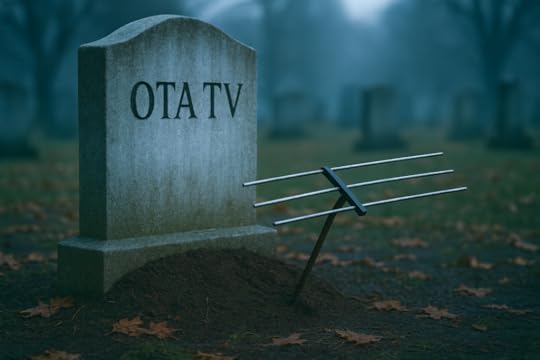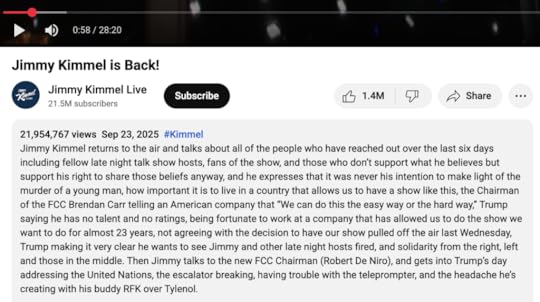On the Continuing End of OTA TV, Part 2
This is Part 2 of a post that began with a Jimmy Kimmel monologue, but really wasn’t about that. It was about the grave situation in which over-the-air (OTA) TV finds itself. Here is Part 1.

Even people who don’t like leftish comedy should admit that Jimmy Kimmel’s monologue after he returned to the air was brilliant. It was also, judging from this—
—a success.
And yet, says Stephen Levy in Wired, Broadcast TV Is a ‘Melting Ice Cube.’ Kimmel Just Turned Up the Heat — After Sinclair and Nexstar pulled Jimmy Kimmel off air, the old affiliate model looks shakier than ever. Even Disney might do better without broadcast.
So let’s dig into that.
The “affiliate model” is the current TV show distribution system. Simply put, networks (primarily ABC, NBC, CBS, Fox, and PBS) sell programming to affiliates. Put another way, they wholesale it. In the business, payments by affiliates to networks for wholesaled programming is called reverse compensation. It’s “reverse,” because from the 1940s to the late 1990s, networks paid stations to carry programming. Now it’s the other way around. (I suppose the same applies to the lesser networks—ion, CW, Daystar, Bounce, Cozi, etc.—but nobody cares much about those. Stephen’s ice cube is mostly the “Big Four” commercial networks.
Here is a table of major affiliate station owners:
Top U.S. Owners of Big Four Network AffiliatesOwnerTotal TV Stations (owned/operated)Big Four AffiliatesNotesSourceNexstar Media Group~197~28–32 ABC (subset shown); majority of portfolio is Big FourLargest U.S. station owner; more than 200 owned/partner stations across 116 markets.Wikipedia;Nexstar;
WTOP (ABC count)Sinclair Broadcast Group~294~41 ABC (subset shown); also major owner across NBC/CBS/FoxAmong the largest owners of Big Four affiliates nationwide.Wikipedia (station list);
NY Post (ABC count)Gray Media~180Largest owner of NBC affiliates (28); strong on ABC & CBS as wellName changed from “Gray Television” to “Gray Media” in 2025; expanding via pending deals.Wikipedia (station list);
Wikipedia (NBC=28)Tegna6856 (22 NBC, 15 CBS, 13 ABC, 6 Fox)Largest owner by audience reach of NBC affiliates; portfolio is predominantly Big Four.Wikipedia (counts by network)E. W. Scripps60+42 (18 ABC, 11 NBC, 9 CBS, 4 Fox)Mix of Big Four & CW/MyNet; numbers exclude recent pending swaps until closed.Scripps investor highlightsHearst Television~34–35~28 (15 ABC, 11 NBC, 2 CBS)Heavy ABC/NBC footprint; minimal Fox.Wikipedia (affiliate mix)Cox Media Group~12Primarily Big Four in major marketsPortfolio trimmed in recent years; still holds key ABC/NBC/CBS/Fox outlets.The Desk (count)Allen Media Broadcasting~28Mostly ABC/NBC/CBS/FoxExploring station sales; partial divestiture to Gray announced Aug. 2025 (pending).Wikipedia;
TheWrap
Sources :
Nexstar station total and footprint; ABC subset count via recent reporting. Nexstar Media Group, Inc.
Sinclair total and ABC subset. Wikipedia
Gray total and NBC=28 claim (plus active list). Wikipedia
Tegna totals and per-network counts. Wikipedia
Scripps Big Four=42. ir.scripps.com
Hearst totals and affiliate mix. Wikipedia
Cox current station count. TheDesk.net
Allen Media size and 2025 divestiture news. Wikipedia
Notes: Counts are from those sources, as of late September 2025. “Total TV stations” often includes stations that are not owned outright, but operate in one of these other ways:
Local marketing agreement (LMA)Joint sales agreement (JSA)Shared services agreement (SSA)If you follow those links to understand how this stuff works, note that Wikipedia’s LMA article covers JSAs and SSAs. The SSA page redirects to the LMA page, and the JSA section is anchored on that same page. Complicated shit, but I feel it’s my duty to lay it out.
I don’t list PBS stations because all PBS affiliates are independently owned. While PBS stations also buy programming wholesale from the network, they retail it to viewers as well as to corporate sponsors.
When Trump and Carr want to politically correct (MAGA-align) station owners by threatening to revoke their broadcast licenses, they are mostly talking about the Big Four networks’ O&O (owned and operated) stations, most of which are in major markets. Here are those, in four tables:
NBC — NBCUniversal Owned Television StationsMarketStationNew YorkWNBCLos AngelesKNBCChicagoWMAQ-TVWashington, D.C.WRC-TVPhiladelphiaWCAUDallas–Fort WorthKXAS-TVSan Francisco–Oakland–San JoseKNTVBostonWBTS-CDMiami–Fort LauderdaleWTVJSan DiegoKNSDHartford–New HavenWVITABC — Disney’s ABC Owned Television StationsMarketStationNew YorkWABC-TVLos AngelesKABC-TVChicagoWLS-TVPhiladelphiaWPVI-TVSan Francisco–Oakland–San JoseKGO-TVHoustonKTRK-TVRaleigh–Durham–FayettevilleWTVDFresnoKFSN-TVCBS — CBS News and Stations (Paramount Skydance)MarketStationNew YorkWCBS-TVLos AngelesKCBS-TVChicagoWBBM-TVPhiladelphiaKYW-TVDallas–Fort WorthKTVTSan Francisco–Oakland–San JoseKPIX-TVBostonWBZ-TVMiami–Fort LauderdaleWFOR-TVBaltimoreWJZ-TVDetroitWWJ-TVMinneapolis–St. PaulWCCO-TV (with satellite KCCW-TV)DenverKCNC-TVPittsburghKDKA-TVSacramento–Stockton–ModestoKOVRAtlantaWUPA (CBS since Aug. 16, 2025)FOX — Fox Television StationsMarketStationNew YorkWNYWLos AngelesKTTVChicagoWFLDPhiladelphiaWTXF-TVDallas–Fort WorthKDFWSan Francisco–Oakland–San JoseKTVUWashington, D.C.WTTGHoustonKRIVAtlantaWAGA-TVDetroitWJBKTampa–St. PetersburgWTVTMinneapolis–St. PaulKMSP-TVPhoenixKSAZ-TVOrlandoWOFL (semi-satellite WOGX)AustinKTBCMilwaukeeWITISeattle–TacomaKCPQNote that some sources (at those links) also list subchannel affiliations as well. Subchannels are secondary channels that stations transmit with their main one. This is why, when I said in Part 1 that I would watch Jimmy’s monologue on WRTV channel 6.1, rather than just “channel 6,” it’s because WRTV also has these subchannels (which I’m copying over from Wikipedia’s WRTV page):
Subchannels of WRTVChannelRes.AspectShort nameProgramming6.1720p16:9WRTV-HDABC6.2480iGritGrit6.3LaffLaff6.4QVCQVC6.5HSNHSN6.6HSN2HSN229.2480i16:9WTTV4.2Independent (WTTK)29.3COZICozi TV (WTTK)Note that the highest resolution on that list is channel 6.1, the ABC channel, with 720p. Technically, that’s HD, but not full HD, which would be 1080i or 1080p. WRTV broadcasts its main channel in relatively low-res 720p because all those other channels need to fit inside the limited bandwidth of its assigned TV channel (in WRTV’s case, channel 25). All OTA TV stations with a pile of subchannels suffer the same trade-off between picture resolution and subchannel count. If you watch TV network streams over the Internet, however, you may get higher resolutions, including 4K, if you watch through Apple TV 4K, Roku, Fire TV, or Google TV.
Channel-packing like this was a big advantage in the early days of digital OTA TV. Those subchannels were meant to take up shelf space on cable guides, thanks to must-carry rules. Back then the best TVs were also “full HD,” which was 1080i or 1080p (the latter is better). Now all the good TVs sold are 4K. You won’t see Best Buy or Costco showing off a 4K TV using an OTA or cable station, because the resolution is too low, and the compression artifacts are too obvious, especially on the largest screen.
Back to the political game being played here.
Trump and Carr want MAGA-aligned affiliates. Simple as that. Sinclair is already there. Nexstar is leaning that way. If Nexstar gets the green light to acquire Tegna, we can assume that all the former Tegna stations would also veer from mainstream to redstream.
But, as broadcast television dies off, it will matter less and less.
The economics of local TV are also awful. For example, the Indianapolis station I most like to watch for local news is WISH/8, which is locally owned by Circle City Broadcasting. From MSN’s :
IndyStar examined WISH-TV’s “Meet the Team” page on its website using the Wayback Machine, which archives billions of webpages across the internet. Between Aug. 24 and Sept. 9, the profiles of more than a dozen employees were scrubbed off the site.
The WISH-TV employees listed below were either terminated or they resigned, left voluntarily after their contract expired, were not offered a new contract, or are otherwise missing from WISH-TV’s current staffing page. They include:
Jeremy Jenkins, daybreak anchorBrittany Noble, daybreak anchorKody Fisher, investigative reporterReyna Revelle, Hispanic culture reporterKyla Russell, reporterDanielle Zulkosky, reporterFelicia Michelle, lifestyle hostParker Carlson, digital journalistEmily Reuben, digital content producerJason Ronimous, digital and assignments managerKyle Fisher, photographerGuillermo Lithgow, photographerKat Lowder, news producerAl Carl, vice president of news at WISHIndyStar public safety reporters Noe Padilla and Ryan Murphy contributed to this article.
John Tufts covers trending news for IndyStar and Midwest Connect. Send him a news tip at JTufts@Gannett.com. Find him on BlueSky at JohnWritesStuff.
This article originally appeared on Indianapolis Star: WISH-TV scrubs these names off its ‘Meet the Staff’ page after 21 employees depart station
I include all that linky credit-passing because professional journalism is shrinking away, and we need to recognize and support the journalists who are still among the employed.
Since newsroom employment turned negative after 2008, U.S. newsrooms have shrunk by about 26%—from roughly 114,000 jobs in 2008 to about 85,000 in 2020—with newspaper newsrooms down 57% over the same span. And those numbers are from a Pew study published four years ago.
I’ve been unemployed since 2019 (after 24 years with Linux Journal), which is fine with me. First, because I’ve aged out of the talent pool. Second, because I’m focused on remaking the way news is done, starting at the local level. That’s what my News Commons series is about.
What I want is to see What’s On replaced by What Matters. It will take some time for us to institutionalize that. But I believe we will.
Doc Searls's Blog
- Doc Searls's profile
- 11 followers




